Searching for details: Author of this page will appreciate comments, corrections and imagery related to the subject. Please contact Anatoly Zak. |
Site news | Site map | About this site | About the author | Testimonials | Mailbox | ADVERTISE! | DONATE! |
||||||||||||||||||||||||||||
World's first space crew flies riskiest mission ever!On October 12, 1964, the USSR continued its pioneering conquest of space orbiting the first multi-member crew onboard the Voskhod ("sunrise") spacecraft. This achievement was made even more sensational by the fact that three cosmonauts blasted into space after only single-pilot missions. However unknown to the world was the unfathomable risk taken by the cosmonauts. Without any viable emergency rescue at liftoff and without spacesuits, the trio faced certain death in case of even a small air leak, let alone a launch failure. Article, photography and design by Anatoly Zak; Editor: Alain Chabot Previous chapter: Vostok-5 and 6 missions
Above: The de-facto founder of the Soviet space program Sergei Korolev (left) and the crew of Voskhod: Vladimir Komarov, Konstantin Feoktistov and Boris Yegorov on the launch pad in Tyuratam before their launch. Credit: RKK Energia |
|||||||||||||||||||||||||||||
| BIG STORY OF VOSKHOD MISSION | |||||||||||||||||||||||||||||
Please help to keep this site open and current! The pace of our development depends primarily on the level of support from our readers. |
|||||||||||||||||||||||||||||
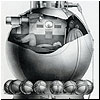 |
If the founder of the Soviet space program Sergei Korolev had had his way, the triumphant mission of Valentina Tereshkova in June 1963, would not have ended launches of the one-seat Vostok spacecraft. Almost a year earlier, plans had been made to launch at least four more Vostok missions aimed to demonstrate to the skeptical Soviet military that manned spacecraft could be more than just a propaganda tool. |
||||||||||||||||||||||||||||
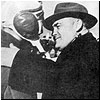 |
At the beginning of 1964, a new plan had emerged to quickly modify the Vostok spacecraft for a series of space firsts: the first multi-member crew and the first spacewalk. According to a popular legend, Soviet Premier Nikita Khrushchev put forward the idea of sending a three-man crew into space after he had learned about US plans to introduce a two-seat Gemini spacecraft and a three-seat Apollo. |
||||||||||||||||||||||||||||
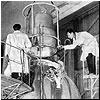 |
To squeeze three cosmonauts into a one-man Vostok, spacesuits would have to be left behind. Moreover, for the first time, the crew would fly without ejection seats and touch down inside its capsule. To address the problem of Vostok's hard landing, the number of its parachutes was increased from one to two and a small cluster of solid rockets was attached to parachute strings. |
||||||||||||||||||||||||||||
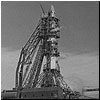 |
The initial concept of the three-seat Voskhod called for keeping the mass of the spacecraft unchanged, however the actual ship gained weight, reaching 5.7 tons. To launch the heavier payload, its rocket was equipped with a new more powerful upper stage. |
||||||||||||||||||||||||||||
 |
During the mission, the crew was assigned a number of experiments, including the study of fluid behavior in weightlessness, star-tracking tests, photo and video documentation. Naturally, a doctor on the crew planned to conduct medical studies. |
||||||||||||||||||||||||||||
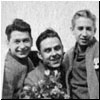 |
With the multi-seat spacecraft, Korolev got his foot in the door of the Air Force monopoly over the cosmonaut selection. Yet, the Air Force demanded that a military engineer and a military doctor fill two available seats. Obviously, such a shameless and completely unfounded usurpation of the prestigious field of manned space flight outraged the civilian industry, which had made the whole thing possible. |
||||||||||||||||||||||||||||
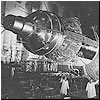 |
The full dress-rehearsal of the Voskhod mission started with a launch on Oct. 6, 1964, at 10:00 Moscow Decree Time, as Korolev watched. After reaching the orbit, the spacecraft was publicly announced as Kosmos-47, obviously, without any clues about its significance for the manned space program. |
||||||||||||||||||||||||||||
|
On October 12, 1964, Voskhod successfully entered orbit with the world's first space crew. Despite sensational headlines around the world, among themselves Soviet space industry insiders dubbed the whole mission a "space circus". |
|||||||||||||||||||||||||||||
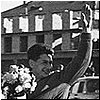 |
After a 24-hour orbital Russian roulette, the Voskhod trio successfully landed totally unaware that the Soviet leader Nikita Khrushchev who had phoned them onboard just hours earlier had now disappeared and been replaced by Leonid Brezhnev after a Kremlin coup ending a crucial era in Russian history. |
||||||||||||||||||||||||||||
| VOSKHOD MISSION AT A GLANCE | |||||||||||||||||||||||||||||
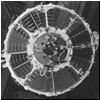 |
|
||||||||||||||||||||||||||||
VOSKHOD MISSION CHRONOLOGY |
|||||||||||||||||||||||||||||
 |
1963 Feb. 8: The Military Industrial Commission, VPK, issues official decision No. 24, approving the development of four Vostok spacecraft during 1963. 1963 Feb. 9: Dmitry Ustinov sends an official request to the Central Committee of the Communist Party for the production of four extra Vostok spacecraft during the first half of 1963. (509) 1963 March 19: Ivan Serbin informs Soviet leaders about the official plan to produce four Vostoks in the 2nd and the 3rd quarter of that year. 1963 March 21: Presidium of the Central Committee requests proposals for follow-on Vostok missions by March 26. 1963 April 13: Kremlin's decree No. 437-150 approves the production of four "military" Vostoks and their rockets, including one in July, one in August and two more in the 4th quarter of 1963. 1963 July 26: The expanded meeting of the Chief Designers reviews results achieved by the Vostok project so far. 1963 Dec. 3: Decree No. 1184-435 calls for the beginning of the 7K tests before the end of 1964 and launching two other components of the Soyuz complex during 1965 and 1966. (466) 1964 January: OKB-1 formulates ideas for the Voskhod project. 1964 Jan. 30: Korolev proposes eight follow-on Vostok missions to Leonid Smirnov. (84) 1964 Feb. 1: Leonid Smirnov rejects the Vostok follow-on program. (84) 1964 Feb. 8: Korolev sends a proposal to Smirnov to fly a modified Vostok with three cosmonauts onboard. 1964 April: Preliminary specifications for the future Voskhod spacecraft are issued. (196) 1964 April 13: The Soviet government issues Decree No. 294-117 formally approving the already ongoing development of a three-seat Voskhod spacecraft. (52) (509) 1964 Aug. 21: A meeting of the Military Industrial Commission reviews the preparations for the Voskhod mission. (466) 1964 Sept. 6: A descent module of the Voskhod spacecraft crashes during a drop test. (466) 1964 Oct. 4: The seven cosmonauts training for the Voskhod mission arrive to Tyuratam to watch the unmanned test launch of the Voskhod spacecraft. (18) 1964 Oct. 5: A second drop test of the Voskhod capsule in Crimea goes as planned. (18) 1964 Oct. 6: An unmanned Voskhod spacecraft enters orbit under the official name Kosmos-47. (466) 1964 Oct. 12: The 3KV spacecraft is launched with Vladimir Komarov, Konstantin Feoktistov and Boris Yegorov onboard. 1964 Oct. 13: The 3KV (Voskhod) spacecraft lands successfully. (466) |
||||||||||||||||||||||||||||
 |
|
||||||||||||||||||||||||||||